Abstract Expressionism 1910 - 1919
by Gary Comenas (2009, Updated 2016)
1910
April 1 - April 17, 1910: "Exhibition of Independent Artists" takes place in New York.
The art in the show was figurative rather than abstract. Robert Henri wrote on article on it in The Craftsman magazine which included black and white reproductions of works by John Sloan (Flying Pigeons), Hilda Ward (The Tenant's Dog), Walt Kuhn (The Tow Team) and Rockwell Kent (Road Breaking).
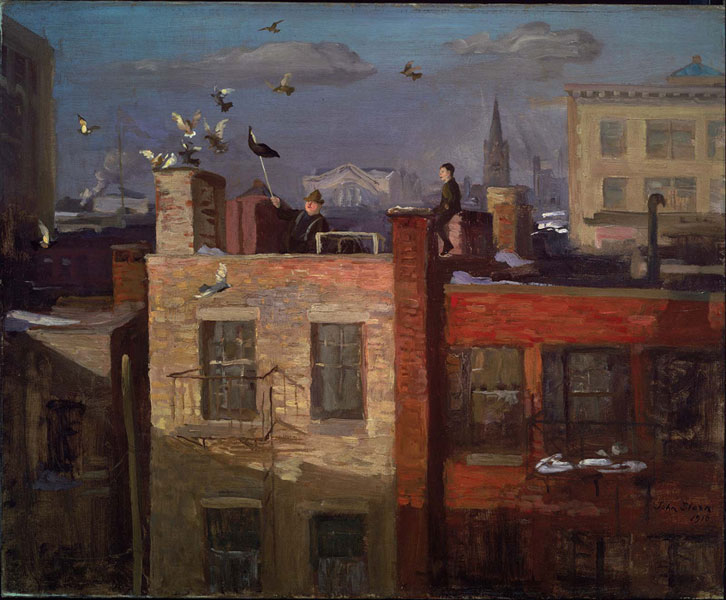
A black and white reproduction of Flying Pigeons (1910) by John Sloan appeared in The Craftsman article
The exhibition was held on three floors in a building located at 29-31 West 35th Street and consisted of 260 paintings, 20 sculptures and 219 drawings and prints. Any artist who could pay the entry fee could submit work which was arranged alphabetically by each artist's last name during the exhibition. Although the exhibition attracted a considerable amount of attention, only five works were sold for a total of $75.00. (FG68-9) Stuart Davis exhibited for the first time at the exhibition. (SD200)
An "editors note" at the end of The Craftsman article indicated the artists who organized the show and the hanging committee members:
From "The New York Exhibition of Independent Artists: By Robert Henri," The Craftsman, Vol. 18, No. 2, May 1910, p. 172:
Editors Note: - The artists who contributed interest, time and money to the organization of this exhibition were John Sloan, Robert Henri, Walt Kuhn, Scott Stafford, W.J. Glackens, Arthur B. Davis, Guy Bene Du Bois, Ben Ali Haggin, Glenn O. Coleman, Dorothy Rice and Clara Tice. - The men on the hanging committee were George Bellows, Buy Du Bois, Robert Henri, Walt Kuhn, James E. Fraser, John Sloan, W. J. Glackens - Secretary and Treasurer, John Sloan.
Henri's article makes several points that are particularly interesting in regard to the development of modern art in the U.S. On page 162, he proclaims "Art cannot be separated from life," just as Allan Kaprow and other artists would later blur the distinction between art and life with their works. On page 167 Henri writes about the beauty of the unfinished product - "A thing that is finished is dead." One could argue that by retaining the mis-registrations of the silkscreen process, Warhol was expressing the beauty of an unfinished product - or at least a product that looked unfinished (something I call 'the perfection of imperfection).
The idea for the "Exhibition of Independent Artists" had been first suggested by John Sloan in December 1909 and was then taken up by Robert Henri, John Sloan, Arthur B. Davies and Walt Kuhn in March 1910 with each of the four artists advancing $200 toward the project. Kuhn, known principally for his portraits of circus performers, would the following year also help form the Association of American Painters and Sculptors which presented the Armory Show in 1913 for which he served as executive secretary. (FG106) He later went on to teach at the Art Students League. In late Autumn 1948 he was committed to Bellevue mental hospital before dying in July 1949 in White Plains, New York.
Artists mentioned in Henri's article who exhibited their work at the Independent Artists show included Rockwell Kent, John Sloan, William Glackens, Jerome Myers, Julius Golx, Arthur Davis (described as "the great imaginator"), Homer Boss, Dorothy Rice, Hilda Ward, George Bellows, Everett Shin, Ernest Lawson, Glen O. Coleman, Edith Dimock, Walt Kuhn, Margaret Eckerson, Edward Keith Jr., Stella Elmendorf, Amy Londoner and Maurice Prendergast.
May 23, 1910: Franz Rowe (Joseph) Kline is born in Wilkes-Barre, Pennsylvania.
Franz Kline was born at home at 140 West River Street - the second child of Anthony and Anne E. Kline (née Rowe). His older brother, born in 1909, was named Frederick. After Franz was born his mother also gave birth to a sister, Louise in 1912 and another brother, Jacques, born in 1916. (FK174) His father had also been born in Wilkes-Barre (on November 28, 1866) and owned a saloon at 177 South Main Street. Franz' mother was born February 14, 1885 in Ludgvan, a small town in Cornwall England, north of Penzance. She came to the United States when she was seventeen years old. After marrying Anthony Kline she decorated the Kline home with reproductions of Turner and Gainsborough. (FK174)
During his high school years, Franz Kline was the artist for the school (Lehighton High School) newspaper which often featured his satirical cartoons. He was also involved in sport. He won a varsity letter playing football and was elected captain of the team in 1929.
He also attended a Military Training Camp during the summer breaks. From July 7 to August 5, 1927 he took basic instruction at the Infantry Branch, Citizens' Military Training Camp, Fort Howard, Maryland. In the summer of 1927-8 he attended the Citizens' Military Training Camp in Fort Monroe Virginia, returning there again in the summer of 1929-30. He studied in England from 1935 to 1938. According to a British Certificate of Registration, his name was Franz Rowe Kline. In 1935 he changed the Rowe to Joseph. (IS58)
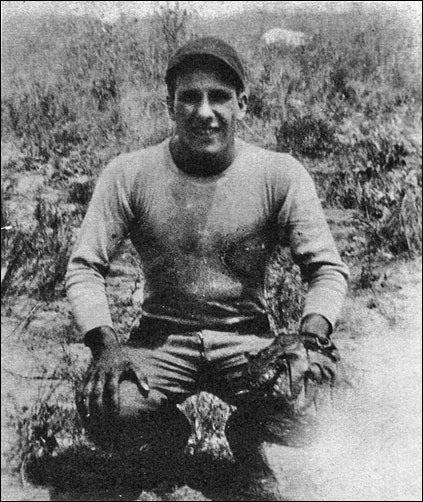
Franz Kline during his military training days
(Photographer unknown) (FK175)
Franz Kline [c.1956]:
People have the crazy idea that an abstract painter doesn't like realism. I like Hyman Bloom's work and, going back further, Ryder's, and even Eakins'. But the thing is that painters like Daumier and Ryder don't ever really paint things the way they look. Nobody can ever look at a boat by Ryder - like a hunk of black tar - and say to me that a boat ever looked like that! Or one of Daumier's faces, composed of slabs of paint, deliberately crude! The final test of painting, theirs, mine, any other, is: does the painter's emotion come across? (CW106)
1911
March 15, 1911: Philip Pavia is born in Connecticut.
Philip Pavia, a sculptor, would later run The Club after it opened in autumn 1949. (IS30) He studied at the Art Students League where he befriended Jackson Pollock and Arshile Gorky. (Gorky did not attend the League as a student but was often a visitor and was well-known to the faculty and students.)
[Note: The correct spelling of his first name is with one "L."]
March 1911: Cézanne at the 291 Gallery.
According to Edward Alden Jewell in a 1933 article in The New York Times titled "Modernism's Pioneer," the work of Cézanne was introduced to the American public at Steiglitz' 291 Gallery with a show of his watercolours in March 1911.
c. March/April 1911: First solo show of Pablo Picasso takes place at the 291 Gallery.
According to Edward Alden Jewell, in April 1911, the 291 hosted Picasso's first solo show with an an exhibition featuring his watercolours and drawings. (AE) According to John Richardson in the second volume of his Pablo Picasso biography, the Picasso exhibition at 291 was in March 1911. (PV310)
From A Life of Picasso, Volume II: 1907-1917 by John Richardson:
It was largely at [Max] Weber's prompting that in March, 1911, he [Steiglitz] put on the first exhibition of Picasso's work in New York: eighty-three drawings and watercolors... crammed onto the walls of the three small rooms that constituted his and Steichen's 291 Gallery. The exhibition supposedly launched Picasso in America. In fact, only one drawing (a Blue Period subject) sold: to Hamilton Easter Field, who paid countless visits to the show and finally shelled out eleven dollars for it. (PV312)
1911: Barnett Newman's family moves to the Bronx.
(Note: The Thomas Hess biography of Newman indicates that Newman's family moved to the Bronx "by 1911." (TH9) The Barnett Newman Foundation chronology notes that the the Newmans moved to the Bronx "by 1915." (MH))
Born on January 29, 1905 in the lower east side of downtown Manhattan, Barnett Newman and his family moved to 1820 Belmont Avenue in the rural Tremont section of the Bronx. Newman attended P.S. 44 on Prospect Avenue. While a student there he won first place in the Junior Four-Minute Speaking Contest. Newman also attended the National Hebrew School in the Bronx where his father was a founding trustee. The Newman children were also taught at home by young Jewish scholars from Europe. According to Newman biographer (and Art News editor) Thomas Hess, the visiting scholars were "young intellectuals on their way to Palestine from Europe, on on their way back from the Middle East to work for the cause" who "would be tossed up in New York, in need of money and a job..." Newman studied the piano as a youth and was as enthusiastic about attending concerts and operas as the home games of the Bronx Orioles - the local semi-pro club. (TH9/MH)
Thomas Hess:
His [Barnett Newman's] education as an artist began early. His mother used to say that as soon as he learned to hold a pencil, he began to make drawings... When he was twelve, he made chalk sidewalk drawings of patriotic subjects, such as George Washington, the American eagle and the defeated Kaiser, at Liberty Bond rallies. Years later, in a symposium, he was asked if he was really the father of "stripe" painting. "If I am the father," he replied politely, "I never had the honor of knowing the mother;" but he regretted the joke, thing that it might be construed by a paranoid New York art world as an attack on Kenneth Noland or Frank Stella. So when the question inevitably was asked at another artists' round-table discussion, he replied that, no, he was really the unknown father of Pop Art and had been the first New York artist to specialize in flags, in 1917, on the streets of New York. Drawing with crayons and chalks was also one of his favorite techniques from 1944 to 1948. (TH10)
November 11, 1911: Roberto Sebastián Antonio Matta Echaurren is born in Santiago, Chile.
The Surrealist Matta immigrated to the United States in 1939. He would remain in the U.S. for about 9 years. Arriving two years earlier than André Breton, the founder of Surrealism, and being a visual artist rather than a literary figure (as Breton was), Matta exerted a strong influence on many of the artists who would later become known as Abstract Expressionists but who, during the early 1940s, were dabbling in Surrealism. He was particularly close to Arshile Gorky - with disastrous results. Matta's brief affair with Gorky's wife Mougouch in 1948 was one of the events leading to Gorky's suicide the same year. Matta was ex-communicated from Surrealism by André Breton not long after Gorky's death, but would be taken back into the Surrealist fold in December 1959 in a performance art ceremony titled Execution of the Testament of the Marquis de Sade at the home of the Surrealist poet Joyce Mansour performed to a tape recording of Breton reading from the Marquis de Sade's Justine.
Art dealer Julien Levy, a neighbour of Matta in Greenwich Village in 1939 later recalled that Matta "was easily the most fertile and untrustworthy of the younger Surrealists." (MA247) Upon Breton's recommendation, Levy gave Matta his first solo show in New York in April-May 1940. In 1942 Matta had his first show at the Pierre Matisse Gallery where he would continue to show until leaving New York in 1948. (SC14-15)
Matta came from an architectural background. He had studied architecture at the Catholic University of Santiago. In 1937 he worked on the Spanish pavilion at the international exhibition in Paris where Picasso's Guernica was first exhibited. (SC13) Still an architect at that time, he met Magritte, Picasso and Miró the same year as the exhibition and through Garcia Lorca and Dali met André Breton, joining Breton's group of Surrealists. Although in 1938 four drawings by him were included in the international Surrealist exhibition at the Galerie des Beaux-Arts Paris, it wasn't until he moved to New York at the end of 1939 that he began to establish his international reputation as an artist. (SC14) According to Levy, he "burst on the New York scene as if he considered this country a sort of dark continent, his Africa, where he could trade dubious wares, charm the natives, and entertain scintillating disillusions." (MA247)
1912
1912: Art dealer Charles Egan is born.
Charles Egan, a native of Philadelphia, would open his gallery in New York (at 63 East 57th Street) in February 1946. He gave Willem de Kooning his first solo show in 1948 and Franz Kline his first solo show in 1950.
(SG98)/The New York Times obituary, March 18, 1993)
January 28, 1912: Jackson Pollock is born in Cody, Wyoming.
Paul Jackson Pollock was the youngest of five children - and the fattest. He weighed 12 1/4 pounds at birth. (JQ/JP20-21) He was born on Watkins Ranch in Cody, Wyoming to Stella May McClure (1875 - 1958) and LeRoy (Roy) Pollock (1876 - 1933). Both parents were born and raised in Tingley, Iowa. Jackson's four older brothers were: Charles Cecil (1902 - 1988), Marvin Jay (1904 - 1986), Frank Leslie (1907 - 1994) and Sanford (nicknamed Sande) LeRoy (1909 - 1963). (PP315)
Although Pollock's "wild west" background in Cody would later be capitalized upon by journalists (and himself) as they went about creating the legend of Jackson Pollock, the truth was that Pollock lived in Cody for less than a year. On November 28, 1912 his mother, Stella May McClure, took Jackson and her other four kids to California to join her husband LeRoy Pollock. He had moved to California the previous month on the advice of his doctor after developing rheumatic fever. In National City (near San Diego). In 1913 they moved to Phoenix, Arizona where Roy was able to buy a 20 acre farm which included an adobe house. (JP)(KV)
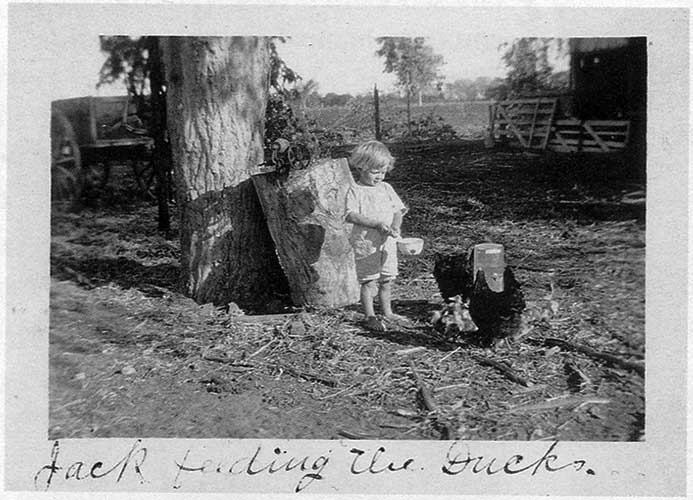
Jackson Pollock feeding the ducks c. 1914 (KV)
Jackson Pollock [from The New Yorker, August 1950]:
... I grew up in the real country. Real country - Wyoming, Arizona, northern and southern California. I was born in Wyoming. My father had a farm near Cody. By the time I was fourteen, I was milking a dozen cows twice a day. (US)
By the time Jackson Pollock was fourteen, he was living in small house in Riverside, California with his mother and brothers. His father had not lived with the family for about six years - having separated from them in 1920.
As with many of the Abstract Expressionists, Pollock would grow up to be an alcoholic. (Just as the drug of choice for Andy Warhol and his cohorts would be "speed," the drug of choice for the AbEx artists was alcohol.) According to the chronology published in Kirk Varnedoe et al., Jackson Pollock (NY: The Museum of Modern Art, 1998), Jackson took his first drink in the summer of 1927 and by autumn, "Although only fifteen, he is drinking heavily." (KV317) With the exception of a two year dry period from about 1947 to 1949 he drank excessively throughout most of his life - both before and after he became famous. (JP211)
Author B.H. Friedman recalled meeting Pollock and his partner Lee Krasner in 1955 when Jackson was noticeably drunk.
B.H. Friedman [author of Jackson Pollock: Energy Made Visible
]:
I first met Lee [Krasner] and Jackson Pollock in the spring of 1955 - that is, slightly over a year before his death... He was already an "old master" of Abstract Expressionism... I was a real estate executive... They were in the apartment because a collector, Ben Heller, was considering buying a painting by Pollock and wanted to bring him to "a friendly environment," one in which he knew a Pollock hung... Now, after a phone call from Heller telling me he had just returned with the Pollocks from East Hampton, they were there... I hung Pollock's jacket in the hall closet and watched him lurch ahead of his wife and down the steps into the living room. From his awkward movements and the few words I heard him mutter, it was clear that he was drunk. Mrs. Pollock [Lee Krasner] whispered, "Don't offer him anything hard - nothing more than beer, if he wants that..."
Pollock lumbered around the room, stopping only to look at the art... For a moment he stood in front of the Mondrian with hands out as if he was about to seize it and fight it. His hands twitched in the air, seeming to want to touch or feel or somehow to reproduce, remake, each element of the work behind him... He looked at the painting again, turned toward me, and asked in a loud thick belligerent voice, "Who did that?" "Mondrian" [I responded]. "Shit, Why don't you have a Cavallon?"... "Shit," Pollock repeated. "You're looking for tame art, familiar art."... I didn't know what I was supposed to say or do. Shout "Shit" back at him? Everyone looked uncomfortable...
Finally Mrs. Pollock spoke: "Come off it, Jackson. you need some sleep." She turned to us. "We get up early to make our appointments in New York. With the stops on the way he gets like this. Is there any place he can take a nap?"
My wife said we had a spare room with a couch in it. She led the Pollocks to the back of the apartment. On the way, in the dining vestibule, opposite the living room, he saw Arshile Gorky's Table Landscape. He stopped in front of it. Again he assumed something like a fighting stance, his hands moving in the air, tracing the configuration of the painting. "That's better," he muttered, "much better." (xv-xviii)
June 11, 1912: William Baziotes is born in Pittsburgh, Pennsylvania.
Baziotes' birth place appears as Reading, Pennsylvania in some sources. (MD275/IS)
Robert M. Coates [The New Yorker (December 23, 1944)]:
There's a style of painting gaining ground in this country which is neither Abstract nor Surrealist, though it has suggestions of both, while the way the paint is applied - usually in a pretty free-swinging, spattery fashion, with only vague hints at subject matter - it is suggestive of the methods of Expressionism. I feel that some new name will have to be coined for it, but at the moment I can't think of any. Jackson Pollock... and William Baziotes are of this school. (JF79)
It was through William Baziotes that Jackson Pollock met Robert Motherwell. Baziotes knew Pollock from the Federal Art Project. (One of the stories that circulated about Jackson was that he tried to push Baziotes out a window during a drunken escapade. (JF26)) When, in the autumn of 1942, Motherwell was looking for artists for a group he was starting to explore Surrealist painting techniques, Baziotes suggested Pollock. Previously, during the winter of 1940/41, Baziotes, Pollock and fellow artist Gerome Kamrowski had experimented with dripping paint onto canvases similar to the Surrealist technique of "automatic" painting.
From Surrealism in Exile and the Beginning of the New York School
by Martica Sawin:
One evening in the winter of 1940 - 1941, Baziotes brought Jackson Pollock over to Kamrowski's studio, and the three artists began experimenting with quick-drying lacquer paint that Baziotes had bought at Arthur Brown's art supply store. They spread some cheap canvases out on the floor and began brushing and then dripping the paint onto them. In the process of "fooling around," as Kamrowski called it, they all worked on the same canvases and during the course of the evening produced a number of collaborative spontaneous works. All three artists already had some knowledge of Surrealism and were familiar with the concept of "pure psychic automatism," and they were trying to find ways in which the new quick-drying paint developed for commercial use could be put to this end. When Kamrowski moved out of that studio... he threw out most of these experimental canvases but kept one as a kind of souvenir, and this three-man canvas has surface in a a number or recent exhibitions as a kind of proto-abstract expressionist work. (SS168)
The painting is known as Painting (winter 1940) and is attributed to William Baziotes, Gerome Kamrowski and Jackson Pollock.
Baziotes was also one of the "irascibles" photographed by Life magazine on November 26, 1950 - a group of artists who protested the Metropolitan Museum of Art's selection of jurors for their "American Painting Today 1950" exhibition. (JF152)
Significant group exhibitions that Baziotes showed in during the 1940s and 1950s included the "First Papers of Surrealism" (October 14 - November 7, 1942); the "Spring Salons" at Art of This Century in 1943 and 1944 (in addition to his first solo show at the gallery in October 1944); the Whitney Annual 1946 (December 10, 1946 - January 16, 1947(JF84-85)); "The Intrasubjectives" exhibition (September 4 - October 3, 1949 (JF134-5)); the "American Vanguard Art for Paris Exhibition" (1951/2); and "15 Americans" at The Museum of Modern Art (April 9 - July 27, 1952).
Baziotes was also one of the founders, along with Robert Motherwell, Mark Rothko and David Hare of the Subjects of the Artist School in 1948. (JF108) (Motherwell also included reproductions of six of Baziotes paintings in his Possibilities magazine. (JF100))
Baziotes died of lung cancer on June 5, 1963 at his home at 90 La Salle Street. He was 52 years old. (MD)
From his New York Times obituary:
Although associated with Abstract Expressionism, Mr. Baziotes could not be classified with any school, and he deliberately held himself apart from organized trends in painting. Surrealist fantasy remained the strongest tradition in his art, but he abandoned the sharply defined representation typical of the school for an abstract manner in which filmy shapes, often suggestive of amoebas or sea life, floated against hazy backgrounds. A meticulous craftsman, Mr. Baziotes was an opponent of the accidental effects and the theatricalism typical of many of his conspicuous contemporaries in the New York School. (WD)
September 5, 1912: John Cage is born in Los Angeles.
John Cage was the music and dance editor of Robert Motherwell's Possibilities magazine. He was also on the faculty at Black Mountain College in 1948 when Willem de Kooning was hired for the summer session. In 1949 Cage lectured on sand painting at The Club.
Although Cage's concepts of randomnness and chance would sometimes be brought into play when art writers wrote about the Abstract Expressionists and "automatic" painting, he didn't agree with their "intentions." In 1966, art writer Irving Sandler asked him why he "was not sympathetic to the Abstract Expressionists aims."
John Cage:
I never agreed with their [the Abstract Expressionist's] intentions. For instance, it was clear in the late forties that the work of Bill de Kooning was of extreme interest. I recall a painting of his, a black-and-white one which had no center of interest and which had been impressed with some newsprint. It had been exhibited for a while at the entrance of the Whitney Museum when it was still on Eighth Street. This painting was one of the most glorious paintings I have ever seen. It was introductory to the very life that I was living.
At this time, I began to write a series of very short pieces by making notations calligraphically on very fine paper. I gave these musical scores as gifts to friends. I wanted to give one to Bill de Kooning. He and his wife, Elaine, used to come to the musical evenings I gave at my apartment down at Grand Street. The idea was that he would give me in return a drawing of his. A meeting took place at which the exchange was to take place. It was late one evening when he had a studio on Fourth Avenue. I gave him immediately my manuscript, and we sat down and in the darkness had a conversation and later he showed me a few drawings, and he could tell that I didn't particularly like them. So I never received a drawing. He said, 'We are different. You don't want to be an artist, whereas I want to be a great artist.' Now it was this aspect of wanting to be an artist - that is to say, wanting to be someone who had something to say, who wanted, through his work, to appear really great - that I had no interest in, and that separated me from even those people who were close friends, and whose work I could use but not in the way they intended... I remember hearing [Harold] Rosenberg say, at an exhibition of Pop and Op art, where is the suffering? I continually have made it clear in my discussions of art that I prefer laughter to tears... (IS257)
Thanksgiving Day, 1912: Jackson Pollock moves to San Diego.
Pollock's father had moved to National City in San Diego County in October after his doctor advised him to move to a warmer climate because he had rheumatic fever. His mother took Jackson (at the age of ten months) and her other children to San Diego on Thanksgiving day. Jackson would never return to to Cody although his birth in Buffalo Bill land would become part of his legend. (JP21)
1913
February 17, 1913: The formal opening of the Armory Show takes place.
The show ran until March 15, 1913.
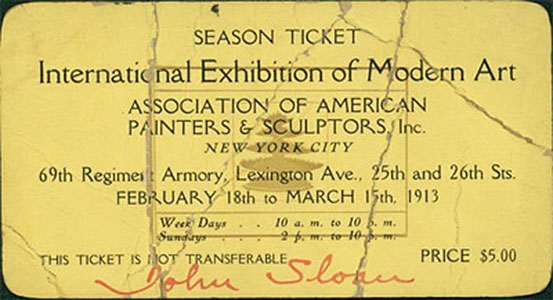
Season ticket for the Armory Show signed by John Sloan
The official name of the Armory Show was "The International Exhibition of Modern Art." It was referred to as the Armory Show because it took place at the armory of the Sixty-ninth Regiment on Lexington Avenue between 25th and 26th Streets. The admission charge was $1 from 10 - 12 a.m, 25 cents from 12 to 10 p.m. and 25 cents all day Saturday and Sunday. (IE)
The date the show opened is different on different documents. A poster indicates that it opened on the 15th. The above season ticket begins on February 18th. The exhibition catalogue gave the opening date as February 17th on the front cover:
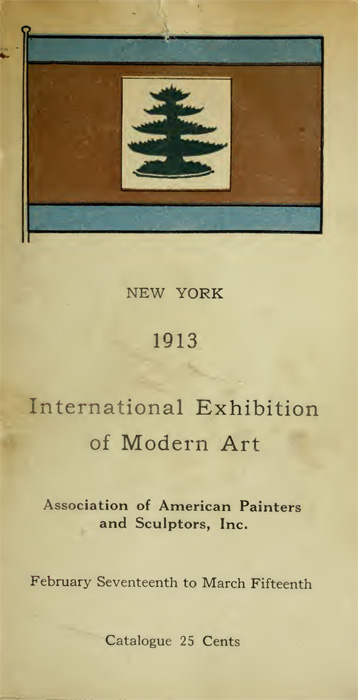
Front cover of the exhibition catalogue for the Armory Show
But the inside title page gave February 15th as the opening date:
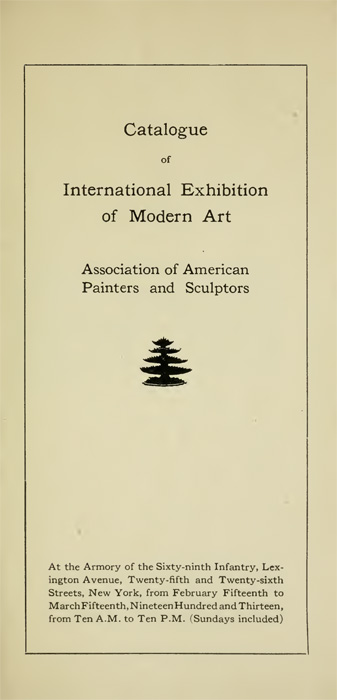
Inside title page of the Armory Show exhibition catalogue
The formal opening of the show was February 17th, as shown on the invitation below. (armoryshow.si.edu)
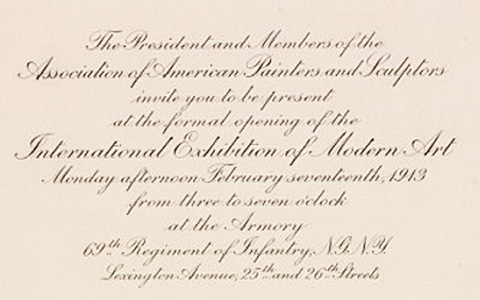
Invitation to the "formal opening" of the Armory Show
Although the show is often credited as introducing European modern art to the United States, at least some of the artists included in the Armory Show had first exhibited in the U.S. at the 291 Gallery which opened in late 1905. According to Edward Alden Jewell in a 1933 article in The New York Times titled "Modernism's Pioneer," Henri Matisse had his first ever American exhibition at the 291 in April 1908 and the work of Cézanne was introduced to the American public there with a show of his watercolours in March 1911. In April 1911 the gallery presented the first solo show of Pablo Picasso with an exhibition featuring his watercolours and drawings. (AE) (According to John Richardson in the second volume of his Pablo Picasso biography, the Picasso exhibition was in March 1911. (PV310)) One of the co-founders of the 291 Gallery, Alfred Stieglitz (who had been made honorary vice president of the group presenting the Armory Show, The Association of American Painters and Sculptors, in the hope that his name would help promote the exhibition) purchased eight works exhibited at the Armory for a total price of $767.50: five drawings by Alexander Archipenko, a drawing by Arthur B. Davis, a Manuel Manolo sculpture and Improvisation #27 by Wassily Kadinsky (which cost $500). Other purchasers included William Macbeth of the Macbeth Gallery who bought an etching of himself by John Sloan for $10. (FG189) Art dealer Frederic C. Torrey bought one of the most controversial works in the show, Marcel Duchamp's Nude Descending a Staircase #2 for $324. (FG107-8)
Art historian Malcolm Goldstein, would later write of the Armory Show, "Of the roughly three hundred contemporary artists represented, nearly half were eventually to drift into obscurity." (FG106) Artist Fairfield Porter thought "the Armory Show was a complete disaster to American art because it made people think that you'd got to do things in a certain style... American art was provincial before... And it became more provincial as a result of the Armory Show." (PC)
From Landscape with Figures: A History of Art Dealing in the United States
(2000) by Malcolm Goldstein:
The exhibition was destined to become the most lengthily described and carefully documented art event in American history. Its own history goes back to 1911 and discussions held by four artists, Walt Kuhn, Elmer L. MacRae, Jerome Meyers and Henry Fitch Taylor, at the Madison Gallery, which was managed by Taylor and owned by Clara Davidge. The four men pondered what steps might be taken to east the task of securing exhibitions of contemporary art and determined to take action. The upshot was the formation of a new organization, the Association of American Painters and Sculptors. Among its members were seven of the Eight [see February 3, 1908], the exception being Shinn. Under the presidency of of Arthur B. Davies and with the legal assistance and general counsel of John Quinn (along with his help in securing the Sixty-ninth Regiment Armory as housing for the exhibition) and the energetic participation of Walt Kuhn as secretary and Elmer McRae as treasurer, the members of the association intended the Armory Show to shake up the esthetic consciousness of the nation. And although seven of the twenty-five members were also members of the National Academy of Design, the association intended its exhibition to rebuke the academy for the staleness and stodginess of its annual exhibitions... It was the plan of the association to stage a series of exhibitions... But in fact the Armory Show was the only one it staged, and in 1916 the association disbanded. Not all of the approximately thirteen hundred exhibits could be described as avant-garde; included among them were works by such past masters as Goya, Corot, Delacrois, and Ingres. Of the roughly three hundred contemporary artists represented, nearly half were eventually to drift into obscurity. (FG105-6)
The exhibition caused considerable controversy, both in New York and after New York when it traveled to Chicago and Boston. In Chicago students at the Chicago Institute of Art demonstrated against the show by staging a trial of Matisse and burning copies of three of his paintings were, along with an effigy named "Henry Hairmattress," set on fire. (SH) The New York Times reviewed the exhibition by interviewing the conventional painter Kenyon Cox about what he thought of the show in an article headlined "CUBISTS AND FUTURISTS ARE MAKING INSANITY PAY." Incorrectly lumping together the modern European artists under the monikers of Cubist or Futurist, the article asked "Is their work a conspicuous milestone in the progress of art? Or is it junk?" Cox thought it was junk.
Kenyon Cox [from The New York Times article (March 16, 1913) p. SM1]:
The Cubists and Futurists simply abolish the art of painting. They deny, not only any representation of nature, but also any known or traditional form of decoration... If they have really expressed their souls in the things they show us, God help their souls!... It began with the Impressionists denying the necessity of any knowledge of form or structure... The next step was for the Post-Impressionists to revolt again... Up to the time of Matisse, the revolutionaries, I believe, were for the most part part sincere enough. They paid for their beliefs with their lives: they made no money out of their beliefs; they committed suicide or died in madhouses. These men have seized upon the modern engine publicity and are making insanity pay.
The "revolutionaries" exhibiting at the show included Paul Cézanne (View of the Domain Saint-Joseph/La Colline des pauvres (c. 1877) ); Vincent van Gogh (Olive Orchard); Edvard Munch (Madonna (1895-1902)); Henri Matisse (The Blue Nude/Souvenir de Biskra (1907), The Red Madras Headress/Mme. Matisse: Madras Rouge (summer 1907) and Red Studio/Panneau rouge (1911)); Pablo Picasso (Head of a Woman/Fernande Olivier (1909)) and Wassily Kandinsky (Improvisation No. 27/Garden of Love (1912).
From A Life of Picasso, Volume II: 1907-1917 by John Richardson:
The Armory show was crucially important for the history of modernism in America, but it did little to enhance Picasso's reputation. Matisse and Brancusi proved far more popular. [Arthur B.] Davies was the only person to buy a Picasso (the relatively minor 1908 gouache Two Trees, for $243). (PV312)
Work by Americans in the show included five works by Robert Henri, five watercolours by Stuart Davis and ten paintings by Albert Pinkham Ryder. (Jackson Pollock would say in 1944 that "The only American master who interests me is Ryder."(JC/SD200/RI))
John Quinn [from his opening comments for the exhibition]:
The members of this association [the Association of American Painters and Sculptors] have shown you that American artists –young American artists, that is - do not dread, and have no need to dread, the ideas or the culture of Europe. They believe that in the domain of art only the best should rule. This exhibition will be epoch making in the history of American art. Tonight will be the red-letter night in the history of not only American but of all modern art…..(we) felt it was time the American people had an opportunity to see and judge for themselves concerning the work of the Europeans who are creating a new art.…..
June 5, 1913: Conrad Marca-Relli is born in Boston, Massachusetts.
It was at Conrad Marca-Relli's studio that Franz Kline met Willem de Kooning in the summer of 1943. Marca-Relli would later recall that ""Bill [de Kooning] and I used to talk until 4 a.m. We would talk about Titian, Piero della Francesca." (DK189))
LIke de Kooning Marca-Relli also had a home in the Springs - near Jackson Pollock's place. After Pollock's funeral in 1956, de Kooning and a few others, including the art dealer Eleanor Ward, gathered at Marca-Relli's home where they were visited by Jackson Pollock's dogs.
Conrad Marca-Relli:
Jackson's dogs came into my house because they were looking for their master. It gave me the creeps. I said something and Bill said, "It's all right. That enough. I saw Jackson in his grave. And he's dead. It's over. I'm number one." I said, "Bill come on. This is something else..." (DK395)
De Kooning went into the garden and Eleanor Ward followed him. When she returned to the house, she said about de Kooning, "He's crying. He's in a very bad mood." According to Conrad, de Kooning wanted Conrad to back him up as "number one" after Pollock died and that de Kooning "felt everyone was supposed to back him up for being number one." (DK395-96)
Marca Relli also lived for a time across the street from Philip Guston when Guston was staying in Florida during 1965 after separating from his wife.
July 27, 1913: Philip Guston is born.
Guston was born Phillip Goldstein in the Jewish section of Montreal, Canada, but moved to Los Angeles with his family in 1919. His Russian-Jewish parents had emigrated from Odessa, Russia to escape persecution in 1905. When Philip was about ten or eleven, his father committed suicide by hanging himself in the shed. Guston found the body. His daughter Musa would later recall that "when Philip was deeply depressed or drunk" he would tell his close friends about his father's suicide. (MM10-11) One of Guston's brothers, Nat, would also die an early death when, in c.1930, he developed gangrene after being hospitalised when he left his car without setting the break and the car hit him, crushing his legs. (MM17)
As a child, Guston showed an early aptitude for drawing. A childhood friend, Ross Feld, recalled that drawing for him was a way of distancing "himself away from the family's shock and grief." (MM13) Guston enrolled at Manual Arts High School in 1927 where he befriended fellow classmate Jackson Pollock. Although Guston also studied for a year at the Otis Art Institute, he was largely self-taught. During the 1930s he worked for the WPA, influenced by American Regionalists and Mexican mural painters. From 1945 - 1947 he taught at Washington University, St. Louis. Although associated with the Abstract Expressionists during the 1950s, he would return to figuration in the 1960s.
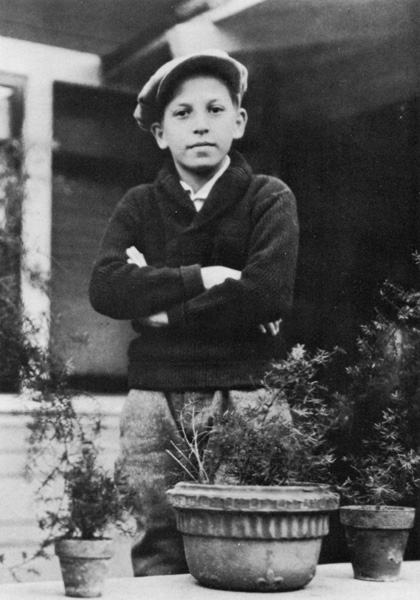
Philip Guston at the age of ten
(From Musa Mayer, Night Studio A Memoir of Philip Guston (London: Thames and Hudson, Ltd., 1991))
Philip Guston [1978]:
As a boy I would hide in the closet when the older brothers and sisters came with their families to mama's apartment for the Sunday afternoon dinner visit. I felt safe. Hearing their talk about illnesses, marriages, and the problems of making a living, I felt my remoteness in the closet with the single light bulb. I read and drew in this private box. Some Sundays I even painted... After a lifetime, I still have never been able to escape my family. It is true that I paint now in a larger closet; much, much larger, with many lights. Yet nothing has changed in all this time. It is still a struggle to be hidden and feel strange - my favorite mood. Or to put it it more precisely, to live my life as a stranger to be vacummed up by family. Such a choice. To breathe or not to breathe... All that I can truly say is that I am still struggling, like a drowning man, to be unrecognizable, unknowable, to myself. The stranger. (MM24)
August 17, 1913: Mark Rothko arrives in the U.S.A. on the SS Czar with his sister Sonia and mother Kate. (RO22)
Rothko's father, Jacob Rothkowitz, had immigrated to America in 1910, following his younger brother Sam who had immigrated to the U.S. in 1891. Sam had settled in Portland, Oregon, changed his name to Weinstein, and became a partner in a clothing business, the New York Outfitting Company. Rothko's brothers, Moise and Albert several months before Rothko, arriving at Ellis Island on January 16, 1913. (RO) Rothko resented immigrating to an unknown land. He later told a journalist that he "was never able to forgive" his "transplantation to a land where he never felt entirely at home." (RO22) He would later comment to Robert Motherwell that "You don't know what it is to be a Jewish kid dressed in a suit that is a Dvinsk not an American idea of a suit travelling across America and not able to speak English." (RO22)
Rothko's first home in America was arranged by his Uncle, Sam - a two story home at 834 Front Street in southwest Portland Oregon in a Jewish ghetto known as "Little Russia." (RO24)
Rothko later recalled that his family "followed and applauded the Russian Revolution" and that he "grew up as an anarchist" commenting that "While I was still in grade school I listened to Emma Goldman and to the I.W.W. [Industrial Workers of the World] orators who were plentiful on the West Coast in those days." (RO35)
September 1913: Jackson Pollock's father, LeRoy, buys a farm in Arizona.
A month after the Pollocks arrived in National City, California a blizzard struck ruining the orange crop and bankrupting farmers and the Pollocks ended up moving to Arizona. They purchased a 20 acre farm just outside of Phoenix. (PP315)
The Pollocks would own the 40 acre farm, purchased with a down payment of ten dollars, for four years. They lived in a small 3 room adobe house and the children would sleep in the back yard in a large brass bed that they all shared from through the warm spring, summer and autumn months. In 1931 LeRoy would write to Jackson's brother Frank, that "The happiest time was when you boys were all home on the ranch. We did lots of hard work, but we were healthy and happy." (JP22-3)
According to another of Jackson's brothers, Charles, their father liked to cultivate his mind as well as his land, listening to classical music and had a small collection of books that traveled with him, often reading aloud to his children from Dickens, Stevenson and Huckleberry Finn. Jackson's brother Charles showed an early talent for drawing and was sent to weekly art classes at the home of Mrs. Bidwell. Jackson, however, showed no such talent. He didn't draw when he was growing up. His brothers would later recall that Jackson took after their father in so far as he had a fondness for animals and would spend lots of time with the family dog, Gyp. Pollock would later name one the dogs he owned as an adult with the same name. (JP24)
1914
1914: Peter Busa is born.
Abstract artist Peter Busa would introduce Arshile Gorky to the Surrealist Matta in 1942 and was one of the artists who met in Matta's studio during the autumn of 1942 to explore Surrealist techniques such as automatism - a group that also included William Baziotes, Arshile Gorky, Robert Motherwell, Jackson Pollock and Gerome Kamrowski. (SS323)
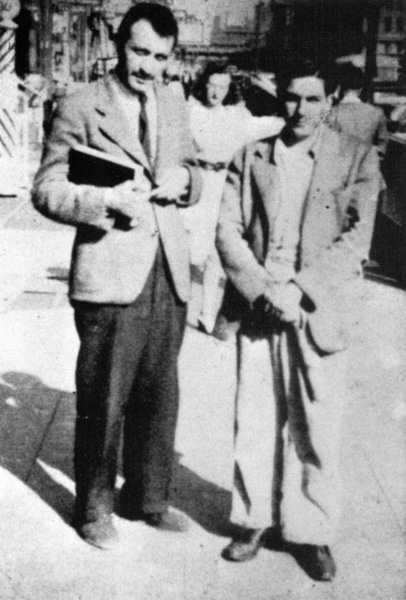
Arshile Gorky and Peter Busa in New York c. late 30s
(Photographer unknown)
Peter Busa:
... through [Alexander] Koslow I came directly to New York and... I enrolled at the League studying with, of all people, Thomas Benton. In that group I met Jackson Pollock and his brother, Sandy [Sande], as well as Charlie who was monitor of the class... But much more effective for my own development in New York was my friendship with Arshile Gorky. And it was Gorky who helped me a great deal by introducing me to Stuart Davis who was perhaps my most fundamental influence of the turn of my work from a Modigliani type of influence to perhaps a more flat and oriented attitude toward two-dimensional structure that has preoccupied me since. It was Gorky who would walk around the streets of New York and point to an itinerant sign that was probably painted by a man who owned a shoe store or a shoe repair store or a man that owned a fish store and he'd say, "This is the most authentic work of art in New York City. (AY)
March 27, 1914: Mark Rothko's father dies of colon cancer at the age of fifty-five. (RO24)
June 28, 1914: Franz Ferdinand is murdered at Sarajevo. World War I begins. (BA59)
September 1914: Mark Rothko and his family move to 232 Lincoln Avenue in Portland, Oregon. (RO33)
1915
January 4, 1915: Robert Motherwell is born in Aberdeen, Washington. (MR131)
Robert Motherwell:
My father was born in the Middle West, in Ohio, When he was a very young man his aspiration, for whatever reason, was to be a banker and to live in California. He was as determined about that as later I was to become a painter. Through a series of events he ended up as a very young man working in a bank in Aberdeen, Washington. And my mother who was very young - I think she was twenty when they met - was the daughter of one of the two local lawyers. And they got married. Ultimately my father succeeded in his dream and became president of Wells Fargo Bank in San Francisco. How he did all that I don't know. He had no connections, no anything. Which also gave rise to the legend that I must be very rich. But the fact is that he was ruined in the Depression and died before he could really recover financially. He died of cancer at a relatively young age...
My mother was very literary. Also she had one of the greatest collections in America of eighteenth-century French Provincial furniture. She used to haunt auction houses for this and as a boy I often used to go with her. And there was a time when I could date any piece of French furniture within two years. I think it was a marvelous training of the eye because, you know, in the end the difference is the exact undulation of the curve, the materials, and so on and all the rest of it. All my life I've used earth colors a lot, especially yellow ochre and raw umber and so on; and I wouldn't be surprised that a lot of it comes from constantly looking at waxed fruitwood furniture. She didn't like the chichi town kind, you know, with gilt and all that, but the beautiful waxed fruitwood country furniture. Where that comes from I don't know. And my grandfather, her father, my Irish grandfather [Sean Hogan] was an intellectual... He was a lawyer. His library was filled with the complete works of Turgenev, Dostoevsky, Darwin. As a child he used to tell me stories all the time. I realize now that he was telling me Paradise Lost or a Greek trilogy, or stories from the Bible; but he would tell them to me as though they were stories...
In may ways they [Motherwell's parents] were quite brutal to me. My mother was a hysteric and used to beat me terribly as a child until the blood ran out of my head. And my father would on occasion, too. So that I grew up terrible nervous and anxiety-ridden and suffocating. You know, I got asthma; what's asthma but not being able to breathe? I couldn't breathe at home... My father used to say to me, "There are only two things I ask of you, that you pass your grades and that you don't get your name in the papers, because that might hurt me." My mother used to call me her Spartan child and she used to say to me from the time I was four, "Come home on your shield or carrying it." You know, really it was an appalling thing to say, as if to say: "Come home dead, or make it..."
And what was very clear to me was the grown-up world - what to me was the grown-up world - which nowadays would be called the WASP world was a bunch of crap. That was very clear to me by the time I was seven. And I wanted to have nothing to do with it... It was all externally directed, status directed, puritanical, materialistic; that everybody was forced to become a fraud, that everybody was playing a role and that they were getting no enjoyment out of the role. In fact, I think I became a permanently-arrested adolescent for years because I didn't want to grow up if that's what being grown up was. (SR)
1915: Mark Rothko and family move to 538 2nd Street in Portland Oregon.
Their new home (the third since Rothko immigrated to the states) was around the corner from their previous home at 232 Lincoln Avenue. They would remain at 2nd Street until after Rothko's graduation from high school. (RO33)
April 1915: The Battle of Van (and the Armenian Genocide) begins.
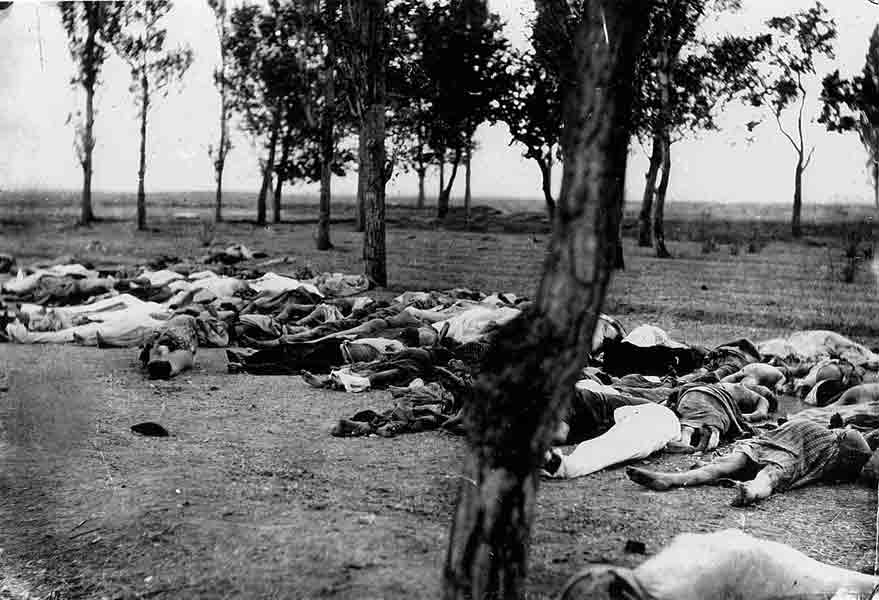
Armenians killed during the Armenian Genocide, originally captioned "Scenes like this were common all over the Armenian provinces, in the spring and summer months of 1915. Death in its several forms - massacre, starvation, exhaustion - destroyed the larger part of the refugees. The Turkish policy was that of extermination under the guise of deportation"
(Henry Morgenthau, Sr, Ambassador Morganthau's Story (1918)
The province of Van was part of the Kingdom of Armenia from about the 2nd century BC to the 4th century AD. The Ottomans (Turkey) took control of the region in 1548 to the displeasure of the native Armenian population who were mostly Christian. Fights would break out between rebellious Armenian groups and the Ottomans. Resentful of being controlled by the Muslim Turks the largely Christian Armenian population would sometimes rebel with disastrous results as the Turks launched crackdowns on the Armenians.
Inside the main city of Van was an American mission headed by Dr. Clarence D. Ussher. According to Ussher, the governor of Van (a Turk) had sent orders to his subgovernors "to exterminate all Armenian males of twelve years of age and over." (BA64) On April 6, 1915, the entire male population (2,500) of the village of Akantz (north-east of Lake Van) was killed by the Turkish invaders. (BA71) On April 24, 1915, 600 Armenian writers, poets, politicians, lawyers were either killed outright or led on forced marches into the desert where they died a slow death. By the time the six week siege was over, more than 55,000 Armenians had been slaughtered and over 15,000 refugees created. (BA73/78)
One of the survivors of the siege was a thirteen year old boy named Vosdanig Manoug Adoian. The young boy would later move to New York and change his name to Arshile Gorky.
1916
1916: John Sloan begins teaching at the Art Students League in New York.
Sloan's students included Alexander Calder, John Graham, Adolph Gottlieb, Barnett Newman and for a short period of time, Jackson Pollock (after Sloan took over Thomas Hart Benton's class at the League when Benton left for New York from December 1932 to September 1933 to work on a mural for the Chicago World's Fair).
Sloan encouraged his students to "study the masters to learn what they did and how they did it, to find a reason for being a painter yourself."
(AG12)
Although considered a Realist artist, Sloan would argue in his book, Gist of Art, published in 1944 that art was more than just the accurate portrayal of visual facts:
John Sloan [From Gist of Art (American Artists Group, 1944)]:
""Many intelligent people have accepted the false idea that accuracy in representing visual facts is a sign of progress in art. Such imitation of superficial effects has nothing to do with art, which is and always has been the making of mental concepts. Even the scientist is interested in effects only as a phenomena from which to deduce order in life." ... "'Looks like' is not the test of a good painting. It indicates merely visual similarity and shows that the artist has not put his brain to work."
1916: Katherine Dreier becomes a member of the Board of Trustees of the Society of Independent Artists.
Dreier (born September 10, 1877 in Brooklyn, New York) came from a privileged background. Her father had made a modest fortune with an iron importing business. (JA)
When the Society of Independent Artists was considering including Marcel Duchamp's readymade sculpture of a urinal, Fountain, in their 1917 exhibition at the Grand Palace, Dreier was one of the people who initially argued against it. She later befriended the artist, however, and Duchamp (and Man Ray) would, in 1920, help her to found the Société Anonyme in 1920.
c. April 1916: Stuart Davis and John Sloan resign from The Masses magazine.
Sloan and Davis resigned from the The Masses after a dispute over artistic control/editorial policy. (SD200/JA)
[Note: The Delaware Art Museum's chronology for John Sloan indicates that in 1914, Sloan "resigned from the Socialist Party and stopped contributing to The Masses," and in April 1916, Sloan "resigned from The Masses and subsequently left the Socialist Party." (JS)]
1917
January 20, 1917: The New York Times announces exhibition planned by the Society of Independent Artists.
From The New York Times [January 20, 1917]:
The Society of Independent Artists, Inc., at last makes its official announcement of existence after more than two years of preparation. Its motto is "No Jury-No Prizes." Its President is William J. Glackens; its Vice President; Charles E. Prendergast; Treasurer, Walter Pach, and Secretary, John R. Covert. The Directors are George W. Bellows, Homer Boss, Katherine S. Drier [sic], Marcel Duchamp, Regina A. Farelly, Arnold Friedman, Ray Greenleaf, C.W. Hawthorne, Rockwell Kent, John Marin, M. B. Prendergast, Man Ray, Mary C. Rogers, Morton L. Schamberg, Joseph Stella, Maurice Sterne, and the officers of the society. The 1917 exhibition is to be held at the Grand Central Palace in April Each exhibitor is promised space fora t least two pictures hung in daylight, with one on the line. The works will be hung in alphabetical order. The only requirements for admission to the society are acceptance of its principles and payment of initiation fee and annual dues. Thus all exhibitors are members. (IA)
March 10, 1917: David Hare is born.
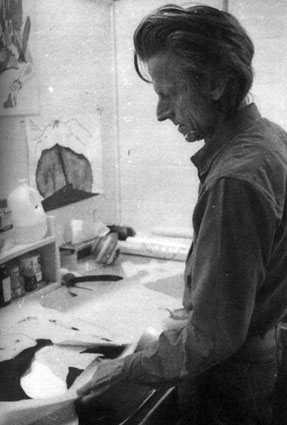
David Hare
(Photographer unknown)
David Hare, a sculptor, painter and photographer, was the cousin of Yves Tanguy's wife, Kay Sage. He was the editor of Andre Breton's magazine, VVV, and was also one of the founders, along with William Baziotes, Mark Rothko and Robert Motherwell of The Subjects of the Artist School which opened in October 1948. He signed with the Samuel Kootz Gallery in 1947:
Samuel Kootz:
One of the first men we had taken on was David Hare in 1947.... he was quite close to the Surrealist concept of immediacy in sculpture and of creating forms that, I should say, had certain possibilities of metamorphosis. He would have in a figure, for instance, a whole side that looked like a foot but actually became a hand and the whole development of the body had a sort of metamorphosis in the creation that made you feel that this was a new kind of thinking about sculpture. (KD)
April 11 - May 6, 1917: Society of Independent Artists exhibition at the Grand Central Palace.
The exhibition became more famous for what it didn't show than what it did. Although all Society members were entitled to exhibit, when Marcel Duchamp submitted his contribution to the show - a sculpture, "Fountain," consisting of a urinal with "R. Mutt" graffittied onto it - the work was hidden behind a partition. In 2004 the same work was chosen as the most influential modern art work of all time by five hundred art experts. (CH)
The New York Times (April 11, 1917) described the exhibition as "Pictures by the mile, hung in a go-as-you-please manner, in alphabetical order, instead of the order of merit" consisting of "more than 2,500 works of art representing more than 1,300 artists," noting that "each artist was allowed to bring in two of his works which he most wished to show." (IN) The result was a melange of styles by artists of varying abilities.
From The New York Times (April 11, 1917):
There are artists doing all lines of work among the exhibitors. There are many with well-known names and those little known - there are pictures which have been made in the war trenches in France, and there are home scenes that are peacefully pastoral. William J. Glackens, Associate National Academician, who is President of the society has for his exhibition Provincetown Girl and Summer, and John R. Covert, the Secretary, whose work is well known in Paris, is showing his cubistic Temptation of St. Anthony, a picture of which the unsophisticated may ask, "Where is St Anthony?" Mrs. Harry-Payne Whitney's Titanic Memorial, so large that a special boat was chartered to ship it from Boston, is the greatest exhibit in size. (IN)
August 1917: Franz Kline's father commits suicide.
An article in the Wilkes-Barre Semi-Weekly Record published on August 24, 1917 described the suicide (by gunshot) and suggested that Kline's father was under financial pressure. After his death, Kline's mother studied nursing and would later work as a nurse. The family lived first at the Episcopal Church Home in Jonestown, Pennsylvania and then with an uncle, William Rowe, in Plymouth, Pennsylvania. (FK174-5)
1918
1918: The Motherwells move to California.
Robert Motherwell and his family moved from Aberdeen, Washington where Robert had ben born.
Robert Motherwell:
... first my father was in Southern California with the Federal Reserve Bank. Then maybe when I was ten we moved to Northern California. When I was twelve I developed horrible asthma, like Proust. It was really ghastly. They thought I was going to die from it. So when I was fifteen I was sent to a prep school in the desert in California. From the prep school I went to Stanford. From Stanford I went to Harvard. From Harvard I went to Paris. So that though my family lived in San Francisco actually I myself was there very little. And never liked it because it was stiff and reactionary like Boston or Philadelphia; and, too, the fog was just literally death on me. So that what I remember is all the time being cold and damp and struggling for air. (SR)
After moving to California the Motherwells would often return to Aberdeen for the summer.
Robert Motherwell [1971]:
Aberdeen was the greatest lumber port in the world. It was a town of about twenty thousand people surrounded by virgin forest and with a magnificent harbour. And all my childhood in this relatively small town there would be a hundred or a hundred and fifty lumber ships from Japan, Finland, Russia, Greece, France, from everywhere loading up with lumber to take all over the world. So though in one sense it was a small town, it was a highly active, internationalised well, in the way that, say, Provincetown is a very small town but a very sophisticated one. Aberdeen was too. Actually our summer barn was on the seacoast about fifteen miles from Aberdeen in a small place called Westport. You see, everything was Scandinavian there on account of all the lumberjacks, and everything was built in Scandinavian wooded style. And there had been a small inn that my mother had gone to as a child with her sisters. It had been abandoned and the local doctor's wife had bought it. Around it were half a dozen houses. My grandfather had one, my father had one. A man named Lance Hart had one. He was the local artist, he was a professor of art at the University of Oregon, he had studied in Stockholm, he had been a childhood boyfriend of my mother's. He was the first artist I had ever met and was one of the loveliest men I ever met. Then several other families had houses. And they all had girls. I was the only boy in all of these houses. So it was ravishing from every standpoint. There were all these girls around and these fantastic beaches, isolation, this marvelous artist to talk to and who taught me how to play poker, and taught me how to make glug, which is a Scandinavian hot drink. So it was a kind of real beautiful holiday from the world...
In Aberdeen there was a little bookstore run by a Russian Jewish woman. Her name was Anna Blume. When I was ten I started going there and using my allowance to buy books. She seemed to me to be an old woman then when I was ten. Several years ago, maybe in 1967 or something, I received a letter from her saying that she had known Chagall in Russia, and was I the same little boy who had become the famous artist, and if I was could she buy a lithograph for her grandson. I sent her one signed. So she's ninety or something now. I used to spend long afternoons in there and we'd have Russian tea and talk about all the books. Actually I was buying ridiculous books like Sabatini and Dumas and so on... For twenty years I read a book a day, from the time I was seven until I was twenty-seven. Now I don't have time to. I learned to sight read... In school. There was course in it and I took it... In the public school... You learned to read scanning the whole page instead of reading word by word by word. It's terrible for poetry but it's marvelous for long things because you get a sense of the whole. (SR)
According to Motherwell, it was around 1918 (when he was three) that he became interested in drawing and painting.
Robert Motherwell:
...I was three, in kindergarten. You see, I'm tone-deaf; I can't carry a tune or recognize one. And in kindergarten a lot of it is dancing and singing and all of that, and I couldn't do it. So they would leave me in a corner with the colouring books or with paper and paints. They had a beautiful blackboard, I still have a feeling, a real slate one and every day at eleven o'clock the teacher would make sort of Miróesque diagrams of what the weather was that day; if it was sunny with an orange oval; if it was raining, with blue lines and green grass. And I can still remember at age three suddenly grasping that forms are symbolic, that it didn't have to look like rain but that blue lines for rain were even more beautiful than an actual photograph of the rain, and so on. And so I determined on the spot that somehow I would learn how to do that. Then in public school in about the second grade they taught me a schema like Raggedy Ann for drawing figures in an abstract way. I also think that there must be psychologically some revulsion against realism, I mean I must have found reality realistically rendered unbearable... And I found real life horrible... I started as an abstract artist. (SR)
February 1918: The Pollocks purchase a farm in Chico, California.
Stella Pollock (Jackson Pollock's mother) had become concerned that Phoenix was becoming a cotton town and a cotton town was no place to raise a family. Family-owned dairy farms were being replaced by large operations. Moving from Phoenix became an obsession. She obtained a stack of postcards and a map of the western United States and wrote to the Chamber of Commerce in most of the cities on the map and received numerous brochures. She decided on Chico California, a citrus farming town, which she had read was the "Rose City of Butte County" and that there was a state college there. On January 18, LeRoy Pollock, who was unsympathetic to Stella's wanting to move, auctioned his animals and sold the farm in Arizona. Their house in Chico was their first with running water and electric lights. LeRoy, however, missed his cows, chickens and hogs and his Phoenix farm. After dinner LeRoy would retire to the living room with a bottle and also took up chewing tobacco - both habits abhorred by Stella. "Stay away from dad" she would tell her sons. "He's got the blues." (JP27)
[Note: According The Museum of Modern Art's Jackson Pollock chronology the move took place in the summer of 1917.]
March 1918: First issue of The Liberator is published.
Edited by Max Eastman, the magazine was devoted to "the struggle of labor" and was in favour of "the ownership and control of industry by workers," as set forth in a one page statement in their first issue. Although many of the writers were pro-Soviet, the magazine promised "complete freedom in art and poetry and fiction and criticism" and that it would "direct its attack against dogmas and rigidity of mind upon whatever side they are found." (VH)
In regard to art, Eastman humbly noted: "I write with a vast uneducation about these matters, but I love some of the paintings so much that even at the risk of offending the more eagle-eyed experts of art, I will make free to say from time to time what I think and feel about them." (VH)
Most of the illustrations in the magazine were satirical drawings and cartoons by Stuart Davis, Cornelia Barns, Maurice Becker, Don Brown, Fred Ellis, Wanda Gag, Hugo Gellert, William Gropper, Louis Ribak, Boardman Robinson and Otto Soglow. (VH) In the August 1918 issue Max Eastman referred to Davis as having "the character of an alley cat," adding "His art lives among the same squalid and strong-smelling and left-out objects, and it goes its sordid way with the suave dirty muscular self-adequate gracefulness of power." (VH)
The last issue of The Liberator was published in October 1924.
1919
1919 - 1926: Robert Motherwell and his family live in Salt Lake City Utah. (RM131)
1919: Adolph Gottlieb drops out of high school.
Gottlieb had been attending Stuyvesant High School. He originally wanted to become an engineer but found that his real interest lied in art. While still a student at Stuyvesant he took a Saturday class at the Art Students League. Gottlieb later recalled "I didn't finish high school - I left high school but then I came back and finished up. In the interim I worked for a while in my father's business, and then I decided I didn't like that." (AS)
March 21, 1919: Franz Kline enrolls at Girard College in Philadelphia.
The college was a free boarding school for fatherless boys. Kline's father had committed suicide in August 1917. Kline attended Girard for six years and was assigned to training in foundry work at the college. On February 1, 1924 he enrolled in the Battalion of Girard College Cadets. (FK175)
1919 - 1923: Barnett Newman attends high school.
Newman attended De Witt Clinton High School in Manhattan, commuting there from the Bronx. The freshman annex was on East 83rd Street and the artist would frequently skip class to visit the nearby Metropolitan Museum of Art. During his first year at high school, Newman took on a middle name, Benedict, a Latin equivalent of his Hebrew name Baruch. Friends called him 'Barney' or 'B.B.' Newman would use the extra "B" in signing his paintings through the mid-1940s and on official documents until his death. (MH)